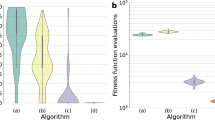Abstract
While defect localization is vital in real-world systems, some limitations inherent to the existing techniques urge us to seek more advanced methods. This paper presents a new approach which takes advantages of genetic algorithms for optimization of non-convex objective function employed in calculating structured residues. The proposed approach so far improved the current principal component analysis (PCA) based on one of the defect localization. It has excellent impact on problem solving while dealing with optimization of residues structuring. The first part illustrates both the PCA model and the traditional residues structuring approach. The principle of optimizing a problem via genetic algorithms is explained later. A proposed objective function to be optimized is defined in the next part, and its optimization via genetic algorithms allows the structured residues computation. The new approach has been applied and proved functional for monitoring the Tennessee Eastman process. We have also proved the efficient performance of the proposed method in comparing it with some state-of-the-art methods.
Similar content being viewed by others
References
Gertler, J.; Formiguera, R.: Leak detection and isolation in water distribution networks using principal components analysis and structured residuals. In: Conference on control and fault tolerant systems, pp. 91–196 (2010)
Mina, J.; Verde, C.; Sanchez-Parra, M.; Ortega, F.: Fault isolation with principal components structured models for a gas turbine. In: American control conference, pp. 197–218 (2008)
Tharrault Y., Mourot G., Ragot J., Maquin D.: Fault detection and isolation with robust principal component analysis. Int. J. Appl. Math. Comput. Sci. 18(4), 429–442 (2008)
Napolitano M., Lacava M.: FDI structural analysis approach for the generation of structured residuals for aircraft. IEEE Trans. Aerosp. Electron. Syst. 45, 1466–1482 (2009)
Li W., Qin S.J.: Optimal structured residual approach for improved faulty sensor diagnosis. Am. Chem. Soc. 44((7), 2117–2124 (2005)
Feng, H.; Li, J.H.: A new robust structured residual generation method based on residual space identification. In: 8th international conference on electronic measurement and instruments, ICEMI ’07, pp. 131–137 (2007)
Gertler J., Li W.: Isolation enhanced principal component analysis. Mixed Hybrid Finite Elem. Methods 45, 323–334 (1999)
Gertler J., Cao J.: Design of optimal structured residuals from partial principal component models for fault diagnosis in linear systems. J. Process Control 15(5), 585–603 (2005)
Weihua L., Sirish S.: Structured residual vector-based approach to sensor fault detection and isolation. J. Process Control 12(3), 429–443 (2002)
Goldberg D., Korb B., Deb K.: Messy genetic algorithms: motivation, analysis, and first results. J. Complex Syst. 5(3), 493–530 (1989)
Zhang J., Chung H., Lo W.L.: Clustering-based adaptive crossover and mutation probabilities for genetic algorithms. IEEE Trans. Evol. Comput. 11(3), 326–335 (2007)
Srinivas M., Patnaik L.: Adaptive probabilities of crossover and mutation in genetic algorithms. IEEE Trans. Syst. Man Cybern. 24(4), 656–667 (1994)
Akbari, R.; Ziarati, K.: A multilevel evolutionary algorithm for optimizing numerical functions. IJIEC. 2(2), 419–430 (2010)
Sung-Hyuk C., Tappert C.: A genetic algorithm for constructing compact binary decision trees. J. Pattern Recognit. Res. 4, 1–13 (2009)
Qin S.J., Dunia R.: Determining the number of principal components for best reconstruction. J. Process Control 10(2–3), 245–250 (2000)
Schmitt L.: Theory of genetic algorithms II: models for genetic operators over the string-tensor representation of populations and convergence to global optima for arbitrary fitness function under scaling. Theor. Comput. Sci. 3, 181–200 (2004)
Sales-Cruz M.: Tennessee Eastman plant-wide industrial process. Technical report, CAPEC. Technical University of Denmark (2004)
Author information
Authors and Affiliations
Corresponding author
Rights and permissions
About this article
Cite this article
Najeh, T., Telmoudi, A.J. & Nabli, L. Genetic Algorithms Applied to PCA–Residues Optimization for Defect Localization. Arab J Sci Eng 40, 2123–2132 (2015). https://doi.org/10.1007/s13369-015-1714-x
Received:
Accepted:
Published:
Issue Date:
DOI: https://doi.org/10.1007/s13369-015-1714-x




